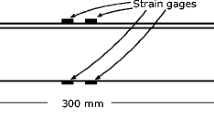Abstract
We propose a method to guide the direction of cracks by utilizing the orientation of Ti-6Al-4V lattice structures produced by powder bed fusion, which has recently attracted considerable attention in additive manufacturing. The fracture characteristics and impact strengths were observed by inserting a diagonal structure with structural anisotropy into specimens of various directions and densities, and it was confirmed that the impact strength differed depending on the differences between the direction of the z-strut, impact direction, and density of the lattice structure. Using this, crack guidance specimens with optimal lattice structures were manufactured along the direction of the cracks, and it was confirmed that cracks were uniformly induced in comparison to single lattice crack guidance specimens. This crack guidance is expected to be used in future machinery in various industries for the protection of important components and shock mitigation in the event of a sudden impact.













Similar content being viewed by others
References
Vrancken, B., Thijs, L., Kruth, J. P., & Van Humbeeck, J. (2012). Heat treatment of Ti6Al4V produced by selective laser melting: Microstructure and mechanical properties. Journal of Alloys and Compounds, 541, 177–185.
King, W. E., Anderson, A. T., Ferencz, R. M., Hodge, N. E., Kamath, C., Khairallah, S. A., & Rubenchik, A. M. (2015). Laser powder bed fusion additive manufacturing of metals; Physics, computational, and materials challenges. Applied Physics Reviews, 2(4), 041304.
Ashby, M. F. (2006). The properties of foams and lattices. Philosophical Transactions of the Royal Society A: Mathematical, Physical and Engineering Sciences, 364(1838), 15–30.
Xiao, Z., Yang, Y., Xiao, R., Bai, Y., Song, C., & Wang, D. (2018). Evaluation of topology-optimized lattice structures manufactured via selective laser melting. Materials & Design, 143, 27–37.
Pham, M. S., Liu, C., Todd, I., & Lertthanasarn, J. (2019). Damage-tolerant architected materials inspired by crystal microstructure. Nature, 565(7739), 305–311.
Campanelli, S. L., Contuzzi, N., Ludovico, A. D., Caiazzo, F., Cardaropoli, F., & Sergi, V. (2014). Manufacturing and characterization of Ti6Al4V lattice components manufactured by selective laser melting. Materials, 7(6), 4803–4822.
Waqas, A., Xiansheng, Q., Jiangtao, X., Chaoran, Y., & Fan, L. (2018). Impact toughness of components made by GMAW based additive manufacturing. Procedia Structural Integrity, 13, 2065–2070.
Kruth, J. P., Badrossamay, M., Yasa, E., Deckers, J., Thijs, L., & Van Humbeeck, J. (2010) Part and material properties in selective laser melting of metals. In: Proceedings of the 16th International Symposium on Electromachining (ISEM XVI). Shanghai Jiao Tong Univercity Press. pp. 3–14
Gao, Z., Li, D., Dong, G., & Zhao, Y. F. (2020). Crack path-engineered 2D octet-truss lattice with bio-inspired crack deflection. Additive Manufacturing, 36, 101539.
Reda, R., Nofal, A., & Hussein, A. H. (2013). Effect of single and duplex stage heat treatment on the microstructure and mechanical properties of cast Ti-6Al-4V alloy. Metallography, Microstructure, and Analysis, 2(6), 388–393.
Zhong, T., He, K., Li, H., & Yang, L. (2019). Mechanical properties of lightweight 316L stainless steel lattice structures fabricated by selective laser melting. Materials & Design, 181, 108076.
Yasa, E., Deckers, J., Kruth, J. P., Rombouts, M., & Luyten, J. (2010). Charpy impact testing of metallic selective laser melting parts. Virtual and Physical Prototyping, 5(2), 89–98.
ASTM, E 23–96, Standard test methods for notched bar impact testing of metallic materials.
Acknowledgements
This study was supported by the Technology Innovation Program funded by the Ministry of Trade, Industry & Energy(MOTIE) of Korea (20010917, Development of automotive parts to improve driving performance and passenger convenience using DfAM-based 3D printing manufacturing technology) and the KITECH internal project (EO210005, Development of a holonic manufacturing system for future industrial environments).
Author information
Authors and Affiliations
Corresponding author
Additional information
Publisher's Note
Springer Nature remains neutral with regard to jurisdictional claims in published maps and institutional affiliations.
Rights and permissions
About this article
Cite this article
Lee, J.H., Park, S.J., Yang, J. et al. Crack Guidance Utilizing the Orientation of Additive Manufactured Lattice Structure. Int. J. Precis. Eng. Manuf. 23, 797–805 (2022). https://doi.org/10.1007/s12541-022-00654-x
Received:
Revised:
Accepted:
Published:
Issue Date:
DOI: https://doi.org/10.1007/s12541-022-00654-x




